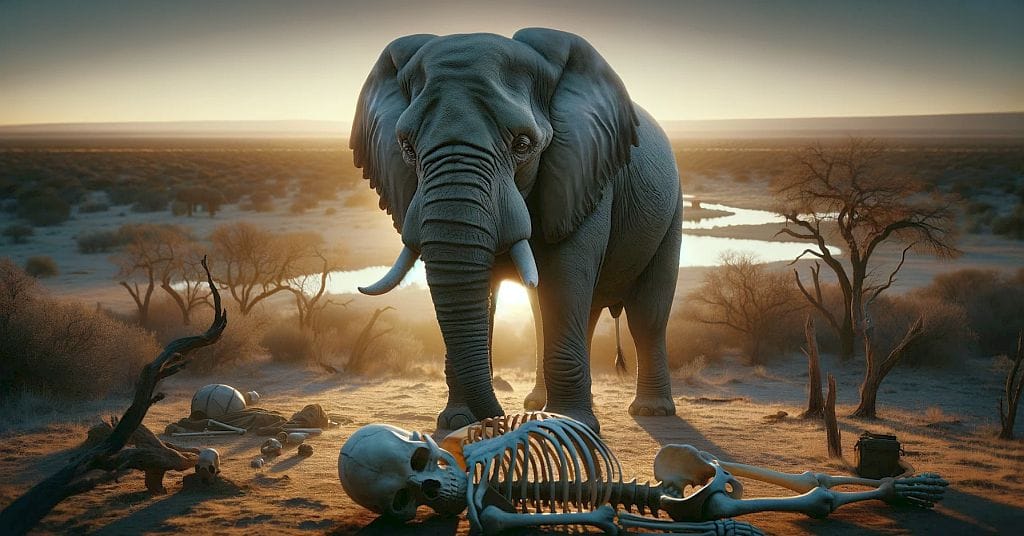 Elephants show behaviors akin to mourning when encountering the bodies of deceased conspecifics.
Elephants show behaviors akin to mourning when encountering the bodies of deceased conspecifics.
Emotions in Animals #
Which of the 20 GEW emotions can be recognized in animals. Provide much detail and reference the research done in this area? #
The Geneva Emotion Wheel (GEW) is a tool developed to assist in the categorization and understanding of human emotions. It features 20 emotions, including joy, pride, relief, hope, interest, surprise, sadness, disgust, contempt, anger, fear, shame, guilt, regret, disappointment, envy, jealousy, frustration, boredom, and anxiety. The recognition of these emotions in animals is a complex and evolving field in ethology and comparative psychology. The extent to which animals experience these emotions akin to humans is subject to ongoing research and debate. However, significant progress has been made in identifying parallels in certain emotions.
Joy and Interest: Positive emotions like joy and interest are commonly observed in many animals, especially mammals. Dogs, for instance, exhibit behaviors interpreted as joy during play or upon greeting their owners. Interest or curiosity is evident in various species exploring new objects or environments.
Surprise and Fear: Surprise and fear are fundamental emotions seen in a wide range of animals. Fear responses are critical for survival, leading to flight or fight reactions, and are well-documented across species, from mammals to reptiles and birds.
Sadness and Grief: Evidence of sadness or grief is most compelling in social animals. Elephants, for example, show behaviors akin to mourning when encountering the bones or bodies of deceased conspecifics.
Disgust: Disgust, primarily as a response to harmful or unpalatable substances, is observed in many species. It’s a basic survival mechanism, evident in animals avoiding spoiled food or harmful substances.
Anger and Aggression: Anger or aggression in animals is often linked to territorial defense, mating rights, or protecting offspring. These behaviors are widespread across various species, from insects to primates.
Anxiety: Anxiety-like states are observed in animals, especially in situations involving uncertainty or threat. This is seen in behaviors like increased vigilance or avoidance.
The emotions like pride, shame, guilt, contempt, regret, envy, jealousy, frustration, boredom, relief, hope, disappointment, and pride are more complex and have been the subject of much debate. These emotions are often considered to be higher-order, with cognitive requirements that some argue may be beyond the capabilities of non-human animals. However, some researchers propose that elements of these emotions can be observed, especially in species with higher social and cognitive abilities like primates and certain marine mammals.
For instance, primates and dogs have been suggested to show signs of jealousy in social situations. Similarly, elements of frustration are observed in animals faced with unsolvable tasks or denied expected rewards.
Key Research References #
Panksepp, J. (2005). Affective consciousness: Core emotional feelings in animals and humans. Consciousness and Cognition, 14(1), 30-80. Bekoff, M. (2007). The Emotional Lives of Animals. New World Library.
King, B. J. (2013). How Animals Grieve. University of Chicago Press.
These studies and observations provide a foundation for understanding animal emotions, but the field is continually evolving with new methodologies and insights, particularly in the realm of cognitive ethology and neuroscience.
Can we make a table? #
Here is a table summarizing which of the 20 Geneva Emotion Wheel (GEW) emotions are recognized in animals:
| Emotion | Recognized in Animals |
|---|---|
| Joy | Yes |
| Interest | Yes |
| Surprise | Yes |
| Fear | Yes |
| Sadness | Yes (in some species) |
| Disgust | Yes |
| Anger | Yes |
| Anxiety | Yes |
| Pride | Debatable |
| Shame | Debatable |
| Guilt | Debatable |
| Contempt | Debatable |
| Regret | Debatable |
| Envy | Debatable |
| Jealousy | Yes (in some species) |
| Frustration | Yes |
| Boredom | Debatable |
| Relief | Debatable |
| Hope | Debatable |
| Disappointment | Debatable |
This table indicates which emotions are generally agreed upon as being observable in animals (“Yes”), those that are seen in certain species (“Yes (in some species)”), and those where there is ongoing debate or insufficient evidence (“Debatable”). The recognition of emotions in animals, especially the more complex ones, remains a subject of considerable research and debate in the fields of ethology and comparative psychology.